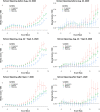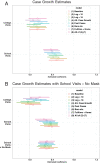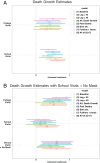The association of opening K-12 schools with the spread of COVID-19 in the United States: County-level panel data analysis
- PMID: 34642247
- PMCID: PMC8545468
- DOI: 10.1073/pnas.2103420118
The association of opening K-12 schools with the spread of COVID-19 in the United States: County-level panel data analysis
Abstract
This paper empirically examines how the opening of K-12 schools is associated with the spread of COVID-19 using county-level panel data in the United States. As preliminary evidence, our event-study analysis indicates that cases and deaths in counties with in-person or hybrid opening relative to those with remote opening substantially increased after the school opening date, especially for counties without any mask mandate for staff. Our main analysis uses a dynamic panel data model for case and death growth rates, where we control for dynamically evolving mitigation policies, past infection levels, and additive county-level and state-week "fixed" effects. This analysis shows that an increase in visits to both K-12 schools and colleges is associated with a subsequent increase in case and death growth rates. The estimates indicate that fully opening K-12 schools with in-person learning is associated with a 5 (SE = 2) percentage points increase in the growth rate of cases. We also find that the association of K-12 school visits or in-person school openings with case growth is stronger for counties that do not require staff to wear masks at schools. These findings support policies that promote masking and other precautionary measures at schools and giving vaccine priority to education workers.
Keywords: K–12 school openings; and remote; debiased estimator; foot traffic data; hybrid; in-person; mask-wearing requirements for staff.
Copyright © 2021 the Author(s). Published by PNAS.
Conflict of interest statement
The authors declare no competing interest.
Figures






References
-
- New York Times, Github Repository. https://raw.githubusercontent.com/nytimes/covid-19-data/master/us-counti.... Deposited 2 February 2021.
-
- MCH Strategic Data, COVID-19 IMPACT: School District Operation Status, https://www.mchdata.com/covid19/schoolclosings. Accessed 28 January 2021.
-
- Callaway B., Sant’Anna P. H., Difference -in-differences with multiple time periods. J. Econom. (2020), in press.
-
- Goodman-Bacon A., Difference-in-Differences with Variation in Treatment Timing, (NBER Working Papers 25018, National Bureau of Economic Research, 2018), 10.3386/w25018. - DOI
-
- Sun L., Abraham S., Estimating dynamic treatment effects in event studies with heterogeneous treatment effects. J. Econom. (2020), in press.
MeSH terms
LinkOut - more resources
Full Text Sources
Medical
Research Materials
Miscellaneous

